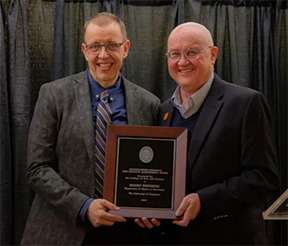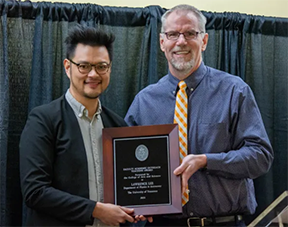The Art of Science
March 20, 2023
Professor Hanno Weitering and Assistant Professor Larry Lee are physicists, but sometimes that means being a designer, architect, musician, or painter. This creative blend of art and science was appropriately rewarded at the annual College of Arts and Sciences awards banquet. Weitering was recognized for his Distinguished Research Career at UT while Lee was honored with the Outreach Teaching Award.

Hanno Weitering w/ Assoc. Dean Larry McKay
Weitering has been at UT since 1993. Part of the condensed matter physics group, he's an experimentalist who's never been afraid to venture into new directions. For years he swore he'd never get involved in superconductivity research. Then he moved to an office next door to Professor Jim Thompson (now retired) and began collaborating on that very topic: a career highlight he chalks up to serendipity.
Weitering is interested in the often-unpredictable electronic properties of low dimensional materials systems. The smaller a system, the more subtle its physics becomes. He explained that many physicists like to find and study exotic electronic properties of materials that he sees as way too complex to truly comprehend. Instead, he prefers to look at theoretical models for those materials that are intuitively "easy" to understand, yet necessarily oversimplify aspects related to a material's chemistry, which can be extremely complex and difficult to control.
"My approach is to create simple materials systems that would be a much closer experimental realization of some of the most promising theoretical models and then see (if) it all makes sense," he said.
This involves some nanoscale architecture. Working with Associate Professor Steve Johnston, he found that silicon—the heart of the electronics industry—can host a novel form of superconductivity. Arriving at that result required him to create a sample comprising a third of a layer of tin atoms on a layer of silicon atoms. This wasn't something he just happened upon, however.
"This was all by design," Weitering said, part of a scientific approach that's "a mix of serendipity and strategy.
"I never really jumped on hot topics," he continued. "Instead I consider, 'What is my expertise? What is my background? Where do I think I can make a really interesting and lasting contribution?'"
This mindset has resulted in a successful research career rounded out by dedicated classroom teaching and 10 years of service as department head, as well as 10 years as deputy director of what's now the Institute for Advanced Materials and Manufacturing.
His hard work has not escaped notice. In addition to this honor from the College, in 2022 Weitering was elected a Fellow of the American Association for the Advancement of Science and appointed a UT Chancellor's Professor.
While appreciative of the honors, he said his creativity is driven by curiosity, not potential accolades.
"You have people that I feel are giants, and they build cathedrals," he said. "I just would like a nice mosaic somewhere on the floor that I'll be remembered by."
While Weitering crafts artwork for theoretical cathedral floors, Lee is literally bringing people to the dance floor.
Giving vintage tech equipment a second life, he engineers audio waveforms to show images from experimental particle physics—painting musical pictures through his ColliderScope project. He's played festivals both in the United State and Europe, delighting crowds by transforming old oscilloscopes into the heartbeat of techno music and cool imagery.

Larry Lee with Assoc. Dean Todd Moore
Lee joined the faculty in 2021 and is both a musician in his own right as well as a particle physicist. When he's creating riffs for ColliderScope he has to give equal weight to each role.
"It's both all the way," he said. "When you're making these complicated sounds there's an interplay between the shape of the sound and the timbral quality of the sound. If I know I want a particular visual to happen, I have to design it in way that will produce a sound that I want."
In other words: he wants good physics and good music.
"It has to be true to science but also musically engaging," Lee explained. "When you draw these shapes, they end up sounding complex and often naturally harsh. You then have the artistic choice to change the way it looks and therefore sounds, or compose around those harsh sounds."
While he didn't invent this method of drawing pictures with music, once he saw it he knew immediately it would be a perfect fit for particle physics outreach.
"It ties in with the electronics that we use and we build for our day-to-day lives," he said.
Lee has an affinity for bringing physics out of the lab and offering it to the public in ways they can understand, appreciate, and enjoy. Last summer he and Assistant Professor Tova Holmes organized a free public viewing of Particle Fever to celebrate the 10-year anniversary of the Higgs Boson discovery. He hopes to put on a ColliderScope show in Knoxville when he can work out the timing with his research and teaching schedule and find the right venue.
With these latest awards, the Department of Physics and Astronomy has won 11 College Convocation Honors since 2016 for outstanding research, teaching, advising, and outreach.